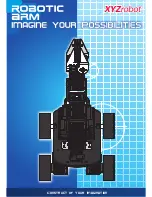
46
Programming manual for Meca500 (for firmware 9.2.x)
TCP/IP COMMUNICATION
never perfectly still since the drives are constantly controlling the motors. This means that the joints
oscillate approximately ±0.001° around the desired joint angles. Thus, if you execute the command
GetRtJointPos
twice in a row while the robot is "not moving", you will see that the joint values may
differ by a couple of micro-degrees.
In a more extreme situation, if a high force is applied to the robot, you will see larger differences
between the real joint set (
GetRtJointPos
) and the desired one (
GetRtTargetJointPos
). The differences
become even larger during rapid motions at high payloads and at a collision.
Each of the
GetRt*
command responses starts with a timestamp, measured in micro-seconds. The
GetRtTargetCartPos
and
GetRtTargetJointPos
return the same data as the deprecated commands
GetPose
and
GetJoints
respectively, except for the timestamp.
All of the commands in this section return responses on TCP port 10000.
2.4.1 GetCmdPendingCount
This command returns the number of motion commands that are currently in the motion queue.
Responses
[2080][
n
]
Note that the robot will compile several (~25) commands in advance. These compiled commands are not
included in this count though they may not yet have started executing.
2.4.2 GetJoints
This deprecated command returns the current target joint set. Use
GetRtTargetJointPos
instead.
Responses
[2026][
θ
1
,
θ
2
,
θ
3
,
θ
4
,
θ
5
,
θ
6
]
–
θ
i
: the angle of joint
i
, in degrees (
i
= 1, 2, ..., 6).
2.4.3 GetPose
This deprecated command returns the current target pose of the robot TRF with respect to the WRF. Use
GetRtTargetCartPos
instead.
Responses
[2027][
x
,
y
,
z
,
α
,
β
,
γ
]
–
x
,
y
,
z
: the coordinates of the origin of the TRF with respect to the WRF, in mm;
–
α
,
β
,
γ
: the Euler angles representing the orientation of the TRF with respect to the WRF, in
degrees.
2.4.4 GetRtAccelerometer
(
n
)
An accelerometer is embedded in link 5 of the Meca500 (i.e., the body with the I/O port), just before
joint 6. It reports the acceleration of link 5 with respect to the
WRF
in the range ±32,000, which
corresponds to ±2g. If the robot is not moving and is installed upright on a stationary horizontal surface,
GetRtAccelerometer
(5) will return roughly {0,0,−16000}, no matter what the joint set. In other words, in
stationary conditions, you can essentially think as if the accelerometer is embedded in the base of the
robot.
Summary of Contents for Meca500 R3
Page 10: ......
















































